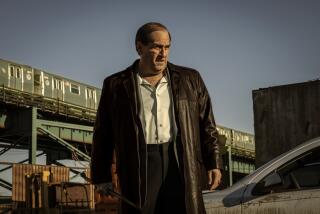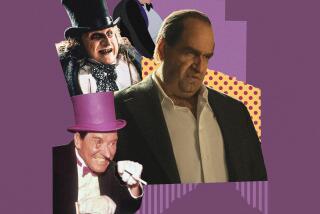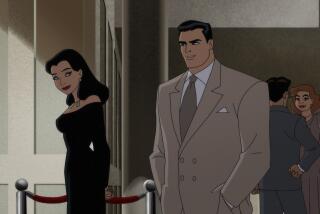THE DARKER SIDE OF BATMAN EMERGES
- Share via
Remember Batman? He was a dashing, upstanding guy in a cowl who chased funny-looking criminals around Gotham City and escaped from cliff-hanging predicaments with the aid of a utility belt chock full of bat-gadgets.
Now, meet the new Batman. He’s in his 50s. He drinks. He dons a cape and haunts the night only when he can no longer endure rampaging urban crime. There’s an injured nobility to him, but he can be vengeful and embittered, and he grins when he hurts muggers. When one criminal pleads “I got rights,” Batman kicks the guy through a window and snarls, “Sometimes I count (your rights) just to make myself feel crazy.”
Holy “Death Wish,” caped crusader! What happened?
What happened is that 29-year-old writer-illustrator Frank Miller has dumped 20 years and lots of darkness on a once-campy superhero. Miller’s book “The Dark Knight Returns” is simultaneously a troubling, violent, adult story and a phenomenon in a world that has become one of the publishing industry’s fastest-growing areas: comic books.
“This will easily be the best-selling comic book of the last five years, and it’s generating lots of interest in non-comics readers,” says Bill Leibowitz, who owns Golden Apple Comics stores, where Miller will make personal appearances today.
At the time of the two-hour appearances (7711 Melrose Ave. at noon, 8962 Reseda Blvd. in Northridge at 3 p.m.), Golden Apple may well be the only retailer in the country to have copies in stock. “The Dark Knight Returns” immediately sold out its first printing, and DC Comics has yet to ship a second batch to capitalize on the attention Miller has been getting in places like the current issue of Rolling Stone. “This is the crossover book,” says Leibowitz. “This is country-and-Western hitting the pop charts.”
It’s also an explosion that has surprised Miller, a soft-spoken, articulate New Englander who startled the comic world in 1979 when he turned “Daredevil” from a run-of-the-mill superhero story into one of the most imaginatively plotted, adventurously drawn and popular comics around. Working with a small group of collaborators who add ink, color and lettering to his pencil drawings, he moved on to an ambitious but less commercially successful series, “Ronin”--and now to Batman.
“I’ve been caught very much off guard, but I’ve been working for and hoping that comics could break into the larger market for some time,” Miller said this week in his Hollywood condominium, which is strewn with the artwork for several upcoming projects (including the remaining three volumes of the “Dark Knight” series).
“Comics need to get more of an adult readership,” he continued, “so that cartoonists can do work that’s worthy of the field. They’ve been stuck in kiddieland for a long time.”x
In part, he says, that’s because the industry voluntarily watered itself down when parents’ groups protested the crime and horror comics of the 1950s. “Comics agreed to be Saturday-morning kid stuff,” he said, “and it’s only recently that there’s been a revolt against that.”
Apparently, it’s worked: Leibowitz says most of Golden Apple’s customers are between 18 and 35, and in the last eight years his business has shifted from 70% back-issue sales to 60% new comics.)
“The Dark Knight Returns” is emphatically not kid stuff: The aging Batman (“sort of like Zorro meets Clint Eastwood,” says Miller) bears no resemblance to the merry crimefighter from TV, and the book itself is a vivid psychological study of a man driven to excess by gnawing memories, a lawless environment and, it seems, a self-destructive streak.
The Batman series is set amid inner-city strife--Miller conceived it while living in New York City--and deals with the current political climate and newspaper headlines. Batman starts a nationwide debate with his lawless tactics. Said Miller, “Think of the noise that came from what Bernie Goetz did, and imagine if there was a very powerful, huge, terrifying figure doing that on a regular basis.”
The idea of reviving a larger-than-life superhero was Miller’s impetus to begin with. “Those old characters are real American myths, even though they were allowed to fall into disrepair,” he said. “When they were created in the 1930s, Batman was a very frightening figure, and Superman was a symbol of the common man rising over the Depression. But they lost much of that power, because they’ve been published every month for 50 years, usually with interchangeable writers and artists.”
More to Read
The biggest entertainment stories
Get our big stories about Hollywood, film, television, music, arts, culture and more right in your inbox as soon as they publish.
You may occasionally receive promotional content from the Los Angeles Times.










